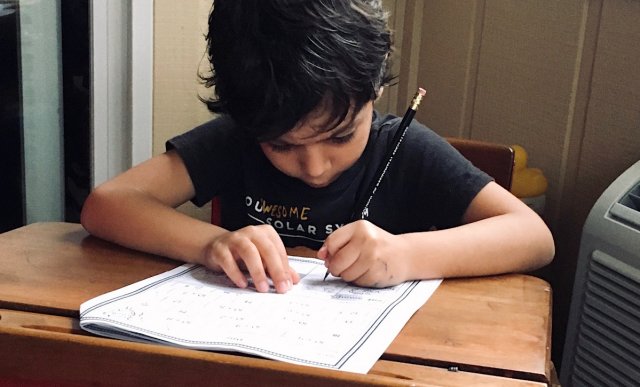
Oklahoma Gov. Kevin Stitt announced his intentions today for the remaining $30 million of the U.S. Department of Education emergency block grant funding provided for use at his discretion by the CARES Act. Three chunks of education dollars will go to:
- $10 million to a Stay in School Fund for low-income students attending private schools;
- $8 million to a Bridge the Gap Digital Wallet program to provide low-income students with $1,500 stipends for curriculum content, technology or tutoring services;
- $12 million to a Learn Anywhere OK effort that will provide access to digital content statewide.
“These programs will allow for students and families of diverse backgrounds to access the quality resources they need in order to continue their education journey amid the COVID-19 pandemic,” Stitt said in a press release distributed just after 4 p.m. Friday. “These are unprecedented times, but we can’t let our kids fall further behind academically. They are our priority, and we will do everything we can to ensure they have the tools they need to succeed in their academic endeavors.”
Stitt had already allocated $8 million of the CARES Act education dollars to the Oklahoma State Department of Education and $1 million so that Tri-County Tech in Bartlesville could offer free tuition for certain students.

Private school scholarships could draw criticism
Stitt had previously floated the notion that he could use some of that funding to support lower-income parents who send their children to private school, and his afternoon announcement fulfilled that idea, with $10 million being allocated to what he is calling the Stay in School Fund. SIS Fund money would provide private school scholarships of up to $6,500 for students. Qualifying students must have attended the same private school last year, but it’s not immediately clear what Federal Poverty Level cap will be applied for eligibility.
Positive Tomorrows CEO Susan Agel said in the governor’s press release that homeless children who attend her school would benefit from Stitt’s decision.
“The children who attend Positive Tomorrows are homeless, so they didn’t have extensive financial resources before COVID-19 and the pandemic certainly didn’t increase opportunity for their families,” Agel said. “The governor’s decision to use federal funds to help these children continue attending our school is literally life changing and perhaps even life-saving, because we not only provide education but also a wide range of services, ranging from clothing to cleaning supplies to emotional support. With this program, Gov. Stitt is making wise use of our tax dollars by investing it in our most precious resource: Oklahoma’s children.”
Chip Carter, president of Cristo Rey Catholic School in Oklahoma City, also praised the private school scholarships.
“Cristo Rey OKC opens the door to a brighter future for children, which is why many of my families are so concerned about the financial stress caused by COVID-19,” Carter said. “This program helps keeps that door of opportunity open, allowing our students to stay in our school and continue to get a quality education and career skills. We greatly appreciate Governor Stitt’s willingness to take a stand on behalf of Oklahoma children and their families.”
The Oklahoma Private School Accrediting Commission has been designated to oversee the distribution of the $10 million in scholarships. Parents can begin applying online Aug. 1. Stitt’s release said that up to 1,500 families of Oklahoma private school students could receive the scholarships, and that families must be able to demonstrate a financial hardship related to COVID-19.
Alicia Priest, president of the Oklahoma Education Association, released a statement about Stitt’s decision to fund private school scholarships.
“Gov. Stitt had $40 million to help support Oklahoma schools, which have been overcoming major challenges to feed, educate, and support children in a time of great fear. In the end, he opted to spend only half of those dollars on public schools,” Priest said. “The governor is using this crisis as a way to funnel emergency funds that our schools desperately need to new, unproven nonprofits and to private schools, which have zero academic accountability. Public schools serve 91 percent of students but are receiving 50 percent of the emergency funding. This is straight out of Betsy DeVos’s playbook. He has taken a stand, and it’s not with Oklahoma’s children.”
Stipends for low-income students
Stitt’s Bridge the Gap Digital Wallet allocation is aimed at helping low-income students obtain items and access necessary for an unprecedented school year. Parents of students near the Federal Poverty Level will be able to qualify for a $1,500 stipend for the purchase of computer equipment or curriculum content to improve their ability to learn.
Stitt’s release said up to 5,000 Oklahoma students could receive the stipend, which can also be used for tutoring services.
“As our students face disruptions from COVID-19 and schools turn to distance learning, we must ensure all Oklahoma students have the supplies necessary to access virtual courses and curriculum, ” Stitt said. “By giving families these funds, we are empowering them to choose what materials are most necessary to make their children successful academically.”
Every Kid Counts Oklahoma — a reform and partnership-focused nonprofit organization — will distribute the Digital Wallet funds.
Statewide digital content access
Stitt’s third allocation of federal education dollars will support public school districts under a Learn Anywhere OK monicker. The $12 million will go toward school districts accessing digital content statewide.
The Stitt administration has established a Learn Anywhere OK website to provide more information about how the digital content opportunities can be accessed by teachers, schools and school districts.
The final line of Stitt’s Friday press release acknowledged the need for personal protective equipment and other considerations, should school resume as planned in the fall:
Gov. Stitt and Superintendent (of Public Instruction Joy) Hofmeister are working closely on assessing the PPE and sanitation needs for school districts across the state to help students, teachers, and staff return safely to the classroom.
(Correction: This article was updated at 6:20 p.m. Friday, July 17, to remove specific reference to income eligibility for the programs discussed above. It was also updated to include comment from Priest.)





















